I have no past. No wild youth to be ashamed about now. When I was young, though, I was frequently drunk. I was drunk, but I was never a drunk; I never came to depend on it. One day, I decided I didn’t want to be drunk any more, and so, from then on, I have never been. I have been buzzed enough to wake up miles past my railroad station but never in a strange hotel room. But if Drudge ever looks for anything in my past, there’s nothing. Sorry. Actually, I think I’ve missed out. Too late now, I guess. In 2003 I began a quest to visit the 14 oldest bars in NYC (according to Forgotten Fan Steve Radlauer, who wrote The Historic Shops and Restaurants of New York with Ellen Williams). Not being a drunk, I’ve been in only a handful thus far. (Until recently I had a responsible job to go to).
McSorley’s

We began our Forgotten NY bar tour on a bitterly cold February afternoon with temperatures in the teens and the impending Blizzard of 2003, which dropped 20″ of snow, quickly to follow, with visits to McSorley’s Old Ale House in the East Village and Chumley’s in the West Village. McSorleys has been an East 7th Street institution since the Franklin Pierce (or Abraham Lincoln) administrations, depending on whose story you believe. It has witnessed everything from the 1863 Draft Riots to the terrorist massacres of 9/11/2001.

Forgotten Fans Jeff (of Streetlight Nuts fame), Rosaura, Eric and Nigey

Though McSorley’s claims it opened here on East 7th Street east of 3rd Avenue in 1854, NYC historian Richard McDermott’s research, employing old insurance maps, census data and tax-assessment records, indicates it opened in 1862. In any case, it’s pretty darn old. The later opening date would negate claims that Abraham Lincoln stopped in when he gave a speech at Cooper Union in February 1860. There are hundreds of pictures on the walls; customers have brought them in throughout the decades, and the staff usually finds a place for them.


In Joseph Mitchell’s era, McSorley’s used four soup bowls for change in lieu of a cash register, one for pennies, nickels, dimes and quarters. The coal-burning stove is still there, as is the safe, the rack of corncob pipes, and the dust-covered set of turkey wishbones hung on a light fixture. The tradition dates to World War I when soldiers going off to war would hang them there. The ones that came back removed their wishbones.
[2011: the City has since made McSorley’s clean the dust off the wishbones]


McSorley’s famously did not admit female patrons until the summer of 1970. At first the bathrooms were unisex until one of the kitchens was converted. But the old place still looks like a woman never set foot in it, until you look around and notice that women seem to be about 60% of the patronage. Photos: Eric Weaver, except the one with Eric in it; that was me.
e.e.cummings on mcsorley’s. he does use a few capital letters, now and then.
Chumley’s

Chumley’s is probably the only major bar or restaurant in New York City that has never had a sign or marking of any sort on its exterior to mark its presence. Yet most Greenwich Villagers know where it is, officially 86 Bedford Street just north of Barrow, and most nights, it’s packed.
Chumley’s building dates to the 1830s and was originally a blacksmithery. According to legend, in the pre-Civil War era it was a stop where escaped slaves could find a haven (there was a black community on nearby Gay Street). At length it became a gathering place for leftist radicals. By 1922, Leland Chumley had established a speakeasy/gambling den in the old building; the tradition of not marking the entrance continues to this day.
During and after Prohibition Chumley’s became one of NYC’s many literary hangouts. The difference here is that the authors’ original dust jackets, and their portraits, line the walls of the place on all sides. You will find just about every big name in 20th Century literature here from Hemingway to Mailer to Ginsburg on the wall.
And mine, as well. The ForgottenBook cover was framed and hung during a book party in September 2006.

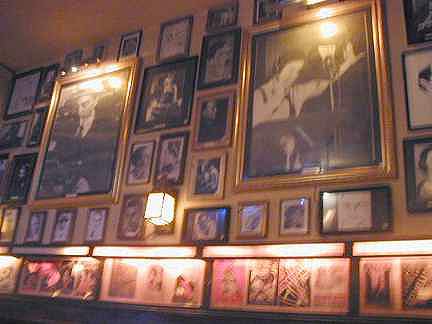
Chumley’s is accessed via a small passageway leading from Barrow Street called Pamela Court. You are likely to find firefighters from the nearby Engine 24 ladder 5 company behind the bar. At right, this is what happens when you don’t use a flash indoors with a digital camera. Are they ever going to fix that? I make out Ring Lardner at left, but not the guy on the right. (Lots of Forgotten Fans say Orson Welles.)
According to legend (which party pooper McDermott disputes) the term “86 it” for “kill it” or “forget about it” comes from a warning the cops would give, phoning ahead to Chumley to let him know they were on the way and customers should “86” or book out the entrance/exit. Photos: Eric Weaver.
[Chumley’s was shuttered in the spring of 2007 because of a wall collapse. It reopened in 2016 under new management.]
Ear Inn
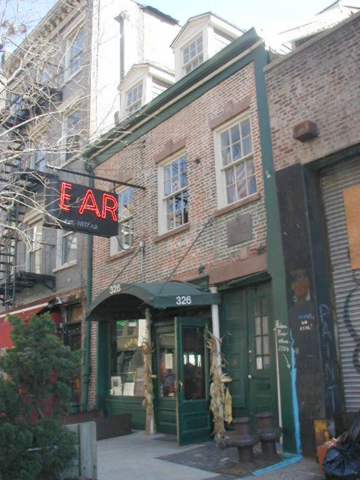

Forgotten Fan Melissa and your webmaster visited the Ear Inn, 326 Spring Street, in March 2003. The venerable place dates to 1817, used to be five feet away from the Hudson River, and is named for a painted-over neon sign.


The Ear Inn is located in a house built by tobacco trader James Brown, who, according to legend (again) was the black man pictured in Emanuel Leutze’s picture of Washington Crossing the Delaware. By the 1850s the place was a brewery in which drinks were served to local stevedores and dock workers; it more or less filled that function for the next 150 years and counting. Landfill gradually distanced it from riverside.
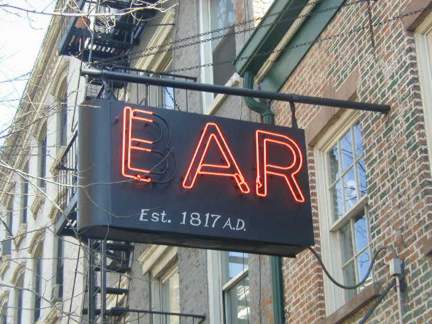

The neon sign dates to the 1940s; in the 1970s, the owners painted out half the “b” and presto, the Ear. Like many of NYC’s oldest joints the Ear is lined stem to stern with ancient photos and memorabilia. Wendell Willkie opposed FDR in the 1940 Presidential election.
Ear Inn Virons: History of the New York City Landmark–James Brown House and West Soho Neighborhood, Andrew Coe, Odyssey Publications 2002
BUY this book at Amazon.COM
Bohemian Hall
Bohemian Hall, 24th Avenue just west of 31st Street in Astoria, was established by Czech immigrants in 1892 as the Bohemian Citizens’ Benevolent Society, which opened the beer garden as we know it today in 1910 and completed it in 1919. Near beer was served the next 11 years.
Your webmaster is accompanied by Gerri and MaryBeth. Yes, they dress like this. All. The. Time.
Beer gardens were quite common especially in German and Eastern European neighborhoods before the dawn of air conditioning, as people tried to escape hot apartments and tenements. They gradually died out, though if the success of the Bohemian is any indication, they should soon make a reappearance. The Bohemian, the Gowanus Yacht Club in Brooklyn, Croxley’s in the East Village, Sullivan’s in Bayside, Queens and Killmeyer’s in Charleston, Staten Island, and a few others, seem to be operating outdoor beer gardens, but there may be more. The Bohemian is the biggest and best.
Though you need to know Czech to read the menu.
Old Town Bar

When your webmaster was young many, many years ago, before sliding into his bitter, discomfited middle age, he frequented the Old Town Bar on East 18th Street between Broadway and Park Avenue South, especially during the summer. The beer was ice cold and the air conditioning was even icier, just the way I like it. Like McSorley’s, the OTB looks pretty much exactly the way it must have when it opened here in 1892.


Opened as Viemeister’s in 1892, it still has its original tile floors, pressed tin ceilings, beveled glass cabinets and light diffusers, wood bar and booths that have hidden compartments to store drinks while the coppers raided during Prohibition.
Forgotten Fans Amy and Martin waste some time at the Old Town with your webmaster in March 2004. It’s likely that the OTB plays a large role in the development of Forgotten NY; in 1981, when I first saw the place, I had no idea that NYC did not eat all of its young and that there were some places still stuck in a time warp. Of course we know that the OTB is a mirage, an aberration, and more and more of the old NYC disappears every year, day by day and minute by minute.
Miller’s Hotel (Waterfront Crabhouse)

In the shadow of the old LIRR Powerhouse (now converted to condos) on Borden Avenue and 2nd Street in Long Island City, you will find the Waterfront Crabhouse, located in a two-story brick building with a red awning. Its present blandish exterior reveals no clue of its former role as Tony Miller’s Hotel, a social epicenter of Long Island City.
Tony Miller constructed a lavish, three-story hotel here in 1881, described as containing a huge horseshoe-shaped bar formed from a single piece of black walnut; three dining rooms; and 30 bedrooms on the third floor. It was quickly able to attract a sizable and star-studded clientele that included architect Stanford White (who co-designed the massive powerhouse a block north), auto racer Barney Oldfield, boxer Tim Sullivan, and entertainer Lillian Russell. Teddy Roosevelt was seen at Miller’s, and Grover Cleveland was spotted drinking at the bar. The hotel benefited from its location next to the westernmost extension of the Long Island Rail Road in Queens, from which ferries were boarded for the cross-river trip to Manhattan.
The hotel lost momentum after Tony Miller’s death in 1897 and the LIRR Manhattan connection to Penn Station was instituted in 1910. In 1919, Prohibition dealt the final blow and the hotel was shut down. The building subsequently served as a phonograph factory, a warehouse, and went through other stints as a restaurant and a hotel for several decades. A 1975 fire claimed the third floor. Restaurateur Anthony Mazzarella opened the Waterfront Crabhouse in 1978, and it has attracted famous visitors just as Tony Miller’s did in the old days: Bobby Hull, Paul Newman, Ed Asner and Maureen O’Hara, and many other sports and entertainment luminaries, have all visited over the years. But the Crabhouse’s true attraction is that it is a sign maven’s Nirvana.
It’s not just a bar/restaurant…it’s a museum. Owner Mazzarella has covered every nook and cranny of this venerable edifice (as the late Lindsay Nelson used to say) with tons of vintage signage, from metal ads to porcelain/steel subway signage.
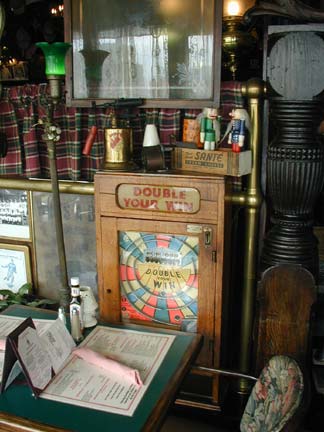

And it’s not just signs. The Crabhouse also has a trove of ancient objects like the typewriter Forgotten NY Correspondent Christina is playing with as well as turn of the century slot games and bookshelves groaning with ancient tomes.
And where would the Waterfront Crabhouse be without a Crabb Lane sign. This was perhaps pilfered from an actual Crabb Lane in NYC, an alley at the western end of Victory Boulevard near Fresh Kills Landfill in Staten Island.
White Horse Tavern

The White Horse Tavern is another of NYC’s long-lived literary hangouts, and yet another with an ancient neon sign. It has been here on Hudson Street and West 11th since 1878, replacing the James Dean Oyster House. And one of the White Horse’s patrons was indeed too fast to live and too young to die.

Forgotten Fans Gordon, Nigey, would’ve been Forgotten Fan Dylan Thomas and Renee. (photo: Eric)
Thomas (1914-1953) was born in Swansea, Wales and surprisingly enough, did not visit the USA until 1950. Thomas first came to prominence as a poet with Eighteen Poems in 1934; his most famous work is perhaps “Do Not Go Gentle Into That Good Night.” His prose works include A Child’s Christmas in Wales and the play Under Milk Wood, both published posthumously in 1954.
From poets.org:
Thomas was the archetypal Romantic poet of the popular American imagination: he was flamboyantly theatrical, a heavy drinker, engaged in roaring disputes in public, and read his work aloud with tremendous depth of feeling. He became a legendary figure, both for his work and the boisterousness of his life.
Without getting into a clinical or psychological tangent on a Forgotten NY page, a field your webmaster is more suited as a patient than as an analyst, it’s a conundrum that has lasted throughout the centuries: why are so many of our most creative individuals given to dissolution and self-destruction? Thomas, the story goes, drank himself to death at the White Horse in November 1953, but the story is more complicated than that: the writer had been quite ill that year, and a number of factors likely contributed to his demise.
A visit to the White Horse today provides a relaxed atmosphere, especially in the front room where you watch the Village go by out the window. Check for how many representations of white horses you can find!
Bridge Café


I’ve saved the oldest for last. The Bridge Cafe, a cozy restaurant/bar at 279 Water and Dover Streets in the shadow of the Brooklyn Bridge approach north of the Seaport area, is in a building that has hosted a tavern or restaurant continuously since 1794; on that, Radlauer/Williams and McDermott all agree.
The Seaport was not always the tourist-friendly haven for Iowans and Michiganders it is now. The impending shutdown of the Fish Market [in 2005] is probably the last straw of its old era, a time of brothels, taverns and gambling joints, and Prohibition speakeasies.
As a resolute law and order kind of person, I can say with a slight pang of regret that as NYC gets safer and cleaner, the more it seems to lose some of a distinctive character. Times Square at its worst, between, say, 1970 and 1990, was never as bad as Five Points was in its hellacious era between 1830 and 1850. Yet, we’ll still be referencing it and talking about the bad old days a lot more than we will the good ones.


I liked the Bridge Cafe’s ambience — unlike McSorleys or the Old Town it combines its old-age sensibility with a modern feel–but I wish NYC restaurants would stop the obsession they have with brunch on Sundays. Larry, Leo, Eric, Nigey and your webmaster staggered in after ForgottenTour 17 in need of red meat only to find a menu full of crepes suzettes at 4PM!
More ancient NYC bars to come, but as anyone familiar with Forgotten NY multi-part pages knows…who knows when?
This page was shot primarily from early 2002 to mid-2004. Text completed March 12, 2005.
PRIMARY SOURCE:
Historic Shops & Restaurants of New York, Ellen Williams and Steve Radlauer, Little Bookroom 2002
BUY this book at Amazon.COM


















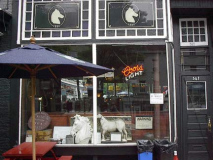
7 comments
Fraunces Tavern?
What about Neir’s Tavern in Queens?
Does anyone remember a great, old, plain bar with wooden booths that I think was called Chambers on E. side of Ave of the Americas at about 55th or 56th St? I’m remembering from 1969-70 era. I would love to see an old picture of it.
Does anyone remember a bar in the ’70s & ’80s in Washington Heights called Walsh’s?
Does anyone remember the Opera Cafe or Cafe Opera on 8th ave in W. Village
trying to find pics of it.. such great times in late 1980s there, any info
helps thnx in advance
Puffy’s? Anyone?
Where was the old Blue Moon Bar in New York City?